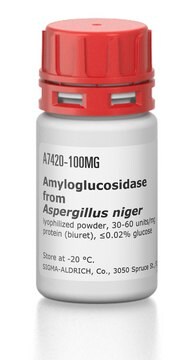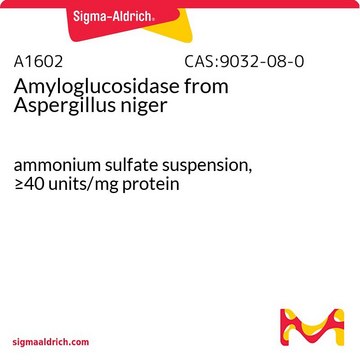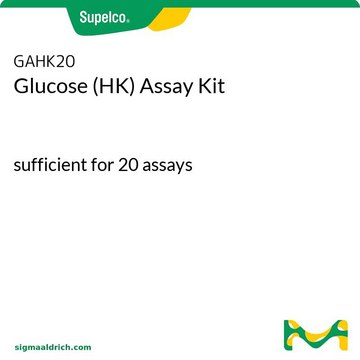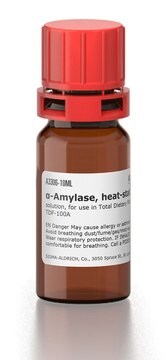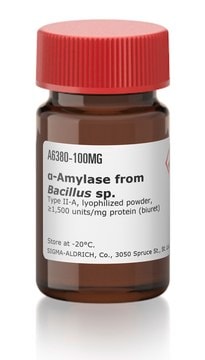ROAMYGL
Roche
Amyloglucosidase
from Aspergillus niger
Sinónimos:
Glucoamylase, disaccharidase-type-α-D-glucosidase
Iniciar sesiónpara Ver la Fijación de precios por contrato y de la organización
About This Item
Productos recomendados
origen biológico
Aspergillus niger
Nivel de calidad
Formulario
suspension
actividad específica
~14 units/mg protein (At 25 °C with glycogen as the substrate; standardized with BSA.)
mol peso
Mr 97 kDa
envase
pkg of 10 mL (10102857001 [100 mg])
fabricante / nombre comercial
Roche
Parámetros
55 °C optimum reaction temp.
pH óptimo
4.6-4.8
temp. de almacenamiento
2-8°C
Categorías relacionadas
Descripción general
Amyloglucosidase is synthesized by several Aspergillus genus species. It is a disaccharidase–type α-glucosidase. This enzyme is an exo-enzyme and one of the major industrial enzymes. The stability of amyloglucosidase can be increased by immobilization.
Especificidad
Cleaves terminal glucoses that are α1,4- or α1,6-linked to an oligo- or polysaccharide of multiple glucose units. The product is D-glucose.
Heat inactivation: Heat inactivation is recommended at 80 °C for 45 minutes, followed by rapidly cooling down.
Heat inactivation: Heat inactivation is recommended at 80 °C for 45 minutes, followed by rapidly cooling down.
Aplicación
Amyloglucosidase from Aspergillus niger can be used for the hydrolyzation of terminal α1,4- and α1,6-glucosidic bonds (glucose-glucose bonds) in polysaccharides (e.g., starch, dextrins, glycogen), removing glucose units sequentially from the non-reducing end of the molecule. The enzyme will also cleave maltose and maltosides (maltotriose, maltotetraose, etc.).
Acciones bioquímicas o fisiológicas
Amyloglucosidase from Aspergillus niger is capable of hydrolyzing the α-D-(1-4), the α-D-(1-6), and the α-D-(1-3) glucosidic bonds of oligosaccharides. Amyloglucosidase is an extracellular enzyme that converts starch to dextrins and glucose. The enzyme is used in the starch-processing industry for the commercial production of D-glucose from corn syrups.
Definición de unidad
Unit Conversion: One unit (+25 °C; glycogen as substrate) corresponds to 8.6 U (+60 °C; starch as substrate).
Forma física
Suspension in 3.2 M ammonium sulfate solution, pH approximately 6
Otras notas
For life science research only. Not for use in diagnostic procedures.
Código de clase de almacenamiento
12 - Non Combustible Liquids
Clase de riesgo para el agua (WGK)
WGK 1
Punto de inflamabilidad (°F)
does not flash
Punto de inflamabilidad (°C)
does not flash
Elija entre una de las versiones más recientes:
¿Ya tiene este producto?
Encuentre la documentación para los productos que ha comprado recientemente en la Biblioteca de documentos.
Los clientes también vieron
Recent Advances in Basic and Applied Aspects of Industrial Catalysis (1998)
A A Amirul et al.
Folia microbiologica, 41(2), 165-174 (1996-01-01)
A. niger produced alpha-glucosidase, alpha-amylase and two forms of glucoamylase when grown in a liquid medium containing raw tapioca starch as the carbon source. The glucoamylases, which formed the dominant components of amylolytic activity manifested by the organism, were purified
High-potency amyloglucosidase-producing mold of the Aspergillus niger group.
Smiley KL, et al.
Applied Microbiology, 12(5), 455-455 (1964)
Nicholson N.
Biodiversity: New Leads for the Pharmaceutical and Agrochemical Industries (2000)
Recent Advances in Basic and Applied Aspects of Industrial Catalysis (1998)
Nuestro equipo de científicos tiene experiencia en todas las áreas de investigación: Ciencias de la vida, Ciencia de los materiales, Síntesis química, Cromatografía, Analítica y muchas otras.
Póngase en contacto con el Servicio técnico


